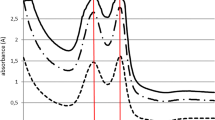Abstract
Adhesion to target cells represents the first step in infection byEntamoeba histolytica. Binding of axenic amoeba (HMI strain) to human red cells in vitro was employed as a model of the adhesion process. The influence of precontact of trophozoites with suspensions of liveSaccharomyces boulardii yeasts, their fractions (membranes and yeast-content supernatant before and after filtration to eliminate the membrane) or yeast culture medium before and after fermentation was investigated.N-Acetylgalactosamine (GalNAC) was employed as the reference inhibitory sugar. The percentage of amoebae bearing red cells after pretreatment of amoebae with the various suspensions and derivates was determined. Adhesion was also evaluated by scanning electron microscopy (SEM). Pretreatment of amoebae with the live yeast suspension led to a significant reduction in the percentage of adhesion [32% vs 70% in the phosphate-buffered saline (PBS) control]. Reduced adhesion was also observed with the filtered and unfiltered supernatant of the yeast suspension homogenate [32% and 34%, respectively, vs 69% in the PBS control], yeast culture medium at the end of fermentation [49% vs 76% in the PBS control] and GalNAC [32% vs 72% in the PBS control]. SEM showed a decrease in the number of amoebae bearing red cells and a reduction in the number of red cells adhering to amoebae. We conclude that substances produced by the yeasts compete with red cells for adhesion sites on amoebae.
Similar content being viewed by others
References
Arroyo R, Orozco E (1987) Localization and identification of anEntamoeba histolytica adhesin. Mol Biochem Parasitol 23:151–158
Bracha R, Kobiler D, Mirelman D (1982) Attachment and ingestion of bacteria by trophozoites ofEntamoeba histolytica. Infect Immun 36:396–406
Cano-Mancera R, Lopez-Revilla R (1987) Inhibition of the adhesion ofEntamoeba histolytica trophozoites to human erythrocytes by carbohydrates. Parasitol Res 74:18–22
Dagnelie P (1975) Théorie et méthodes statistiques. Presses Agronomiques, Gembloux
Diamond LS, Harlow DR, Cunnick CC (1978) A new medium for the axenic cultivation ofEntamoeba histolytica and otherEntamoeba. Trans R Soc Trop Med Hyg 72:431–432
Essner E, Schreiber J, Griewski RA (1978) Localization of carbohydrate components in rat colon with fluoresceinated lectins. J Histochem Cytochem 26:452–457
Kidby DK, Davies R (1970) Invertase and disulphide bridges in the yeast wall. J Gen Microbiol 61:327–333
Kobiler D, Mirelman D (1980) Lectin activity inEntamoeba histolytica trophozoites. Infect Immun 29:221–225
Lampen JO (1968) External enzymes of yeast: their nature and formation. Antonie van Leenwenhoek; J Microbiol Serol 34:1–18
Laughlin J, Aley S (1985) The biochemistry and functional morphology of theEntamoeba histolytica. J Protozool 32:221–240
Lopez-Revilla R, Cano-Mancera R (1982) Adhesion ofEntamoeba histolytica trophozoites to human erythrocytes. Infect Immun 37:281–285
Martinez-Palomo A, Gonzalez-Robles A, Chabez B, Orozco E, Fernandez-Castelo S, Cervantes A (1985) Structural bases of the cytolytic mechanisms ofEntamoeba histolytica. J Protozool 32:166–175
Mirelman D (1987) Ameba-bacterium relationship in amebiasis. Microbiol Rev 51:272–284
Mora-Galindo J, Martinez-Palomo A, Gonzales-Robles A (1982) Interaccion entreEntamoeba histolytica y el epitelio cecal del cobayo. Estudio cuantitativo. Arch Invest Med Mex 13:233–243
Neal RA (1951) Some observations on the variation of virulence and response to chemotherapy of strains ofEntamoeba histolytica in rats. Trans R Soc Trop Med Hyg 44:439–452
Orozco E, Martinez-Palomo A, Gonzalez-Robles A, Guarneros G, Mora-Galindo J (1982a) Las interacciones entre lectina y receptor median la adherencia deEntamoeba histolytica a cellulas epiteliales. Relacion de la adhesion con la virulencia de las cepas. Arch Invest Med Mex 13:159–166
Orozco E, Martinez-Palomo A, Guarneros G, Kobiler D, Mirelman D (1982b) Receptors participantes en la adherencia deEntamoeba histolytica a eritrocitos humanos. Arch Invest Med Mex 13:177–183
Perez-Tamayo R (1986) Pathology of amebiasis. In: Martinez-Palomo A (ed) Human parasitic diseases and amebiasis, Vol 2, Elsevier, New York, pp 71–74
Petri A, Smith RD, Schlesinger PH, Murphy C, Ravdin JI (1987) Isolation of the galactose-binding lectin that mediates the in vitro adherence ofEntamoeba histolytica. J Clin Invest 80:1238–1246
Ravdin JI, Guerrant RL (1981) Role of adherence in cytopathogenic mechanisms ofEntamoeba histolytica: study with mammalian tissue culture cells and human erythrocytes. J Clin Invest 68:1305–1313
Ravdin JI, Guerrant RL (1982) A review of the parasite cellular mechanism involved in the pathogenesis of amebiasis. Rev Infect Dis 4:1185–1207
Ravdin JI, John JE, Johnston L, Innes DJ, Guerrant RL (1985a) Adherence ofEntamoeba histolytica trophozoites to rat and human colonic mucosa. Infect Immun 48:292–297
Ravdin JI, Murphy CF, Salata RA, Guerrant RL, Hewlette EL (1985b) TheN-acetyl-D-galactosamine-inhibitable adherence lectin ofEntamoeba histolytica. I. Partial purification and relation to amebic virulence in vitro. J Infect Dis 151:804–815
Rigothier MC, Vuong PN, Gayral P (1989) Nouveau modèle expérimental d'amibiase caecale chez le rat. Ann Parasitol Hum Comp 64:185–199
Rigothier MC, Macario J, Vuong PN, Gayral P (1990) tEffects des levuresSaccharomyces boulardii sur les trophozoïtes d'Entamoeba histolytica in vitro et dans l'amibiase caecale du jeune rat. Ann Parasitol Hum Comp 65:51–60
Rodriguez MA, Hernandez F, Santos L, Valdez A, Orozco E (1989)Entamoeba histolytica: molecules involved in the target cell-parasite relationship. Mol Biochem Parasitol 37:87–100
Rosales-Encina JL, Meza I, Lopez de Leon A, Talamas-Rohana P, Rojkind M (1987) Isolation of a 220 kilodalton protein with lectin properties from a virulent strain ofEntamoeba histolytica. J Infect Dis 156:790–797
Singh BN, Das SR, Saxena U (1963) Virulence ofEntamoeba histolytica from India with an account of a method for obtaining cent per cent infection in rat. Ann Biochem Exp Med 23:237–242
Vinayak VK, Naik SR, Sawhney S, Sehmi N, Chhuttani PN (1977) Pathogenicity ofEntamoeba histolytica. Virulence of strains of amoeba from symptomatic and asymptomatic cases of amoebiasis. Indian J Med Res 66:935–941
Author information
Authors and Affiliations
Rights and permissions
About this article
Cite this article
Rigothier, M.C., Maccario, J. & Gayral, P. Inhibitory activity of saccharomyces yeasts on the adhesion ofEntamoeba histolytica trophozoites to human erythrocytes in vitro. Parasitol Res 80, 10–15 (1994). https://doi.org/10.1007/BF00932617
Received:
Accepted:
Issue Date:
DOI: https://doi.org/10.1007/BF00932617




